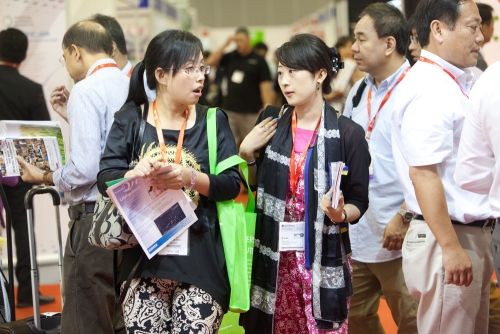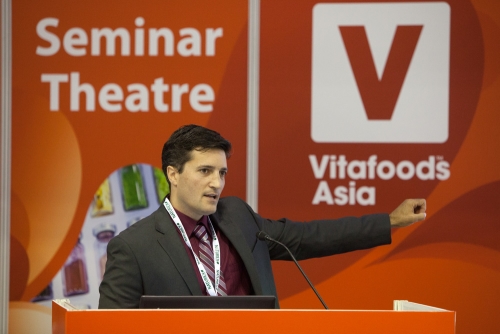The fourth edition of Vitafoods Asia will take place in Hong Kong from September 3-4, 2014.
It will hold a series of activities for the international community to forge business partnerships, discover ingredients and technologies, uncover market opportunities, as well as understand issues such as obesity and cardiovascular disease for product success.
Show organizer Informa Exhibitions says more than 170 suppliers from Asia and beyond will be presenting their latest ingredients and raw materials at the show to 2,500 visitors.
At the show, visitors can have access to New Product Zone that showcases ingredients that have been launched into the market in the past 12 months, the Finished Products Pavilion, the Tasting Bar.
To help show visitors gain more knowledge about the changing industry trends, Vitafoods Asia will for the first time hold several presentation sessions, product showcases and conference.
Chris Lee, portfolio director of Vitafoods Asia, shares more details about these activities and his take on the industry with Food News International.
FNI: How has the Asian nutraceutical market grown over the last decade?
Lee: Over the last decade, growth in the Asia Pacific nutraceuticals product market has been driven by dietary supplements and functional food segments.
Japan and China have been the top consumers of nutraceuticals products in the region, and were forecasted to have 54.8% and 39.5% respectively, of the region’s nutraceuticals market share in 2017, according to a 2012 report by Research and Markets.
More recently, a 2014 report by Euromonitor shows that the Asian market for functional food increased by almost 70% in the period of 2008-2013, which corresponds to a compound annual growth rate of 11.2%.
In fact, Asia is contributing to global sales of functional foods in a huge way.
According to Euromonitor, infant formula is undoubtedly the fastest growing functional food, adding almost US$5 billion in global sales in 2013.
The bulk of this growth is from Asia, in particular China, where an expanding middle class’ aspirations for their children are causing them to buy into the functional promises made by infant formula.
FNI: What are the factors driving such growth?
Lee: There are several factors that drive the development of functional food and drink market.
They include consumer awareness about the positive link between diet and health is at an all-time high and higher disposable incomes.
Apart from maintaining a healthy diet, consumers take food supplements as a means to enhance their health performance or prevent diseases.
In addition, the macro-level problems of soaring obesity rates and an ageing population are leading to higher incidence of health issues such as a loss of sight, diabetes, muscle atrophy, and cardiovascular disease.
Consequently, consumers see the functional food and drink industry to fulfil their health needs, apart from relying on traditional healthcare providers.
FNI: Where is this growth leading nutraceutical manufacturers in the next two years?
Lee: We expect ingredients such as Omega-3s to continue to perform well due to its high recognition.
We will likely continue to see new products for ageing consumers, ‘beauty from within’ innovations, as well as energy and sports nutrition.
At the same time, new areas of research (such as on personalized nutrition and nanotechnology) are also unveiling opportunities for new functional products currently unimaginable to enter the market.
The next few years are likely to be an interesting time for the nutraceutical industry.
FNI: How have trends such as product safety and regulatory approvals affected the way nutraceutical manufacturers operate in Asia?
Lee: Regulatory approval is indeed one of manufacturer’s primary concerns as each country has its set of legislations.
Both ingredient and finished product manufacturers must be extremely sensitive to these regulations, especially if they are intended for cross-boundary distribution, while making sure that products comply with requirements right from the development stage.
Similarly, food safety is another huge concern in Asia, where high profile scandals have broken the trust that consumers used to have in manufacturers.
In this area, regulations help to improve the situation but issues of counterfeiting fake food and poor standards still prove to be problematic.
This negatively impacts the global food industry, creating complications for manufacturers hoping to enter the Asian market.
In Southeast Asia, countries are looking to standardize food industry standards by 2015, in time for the deadline for Association of Southeast Asian Nations (ASEAN) Harmonisation.
The ASEAN Food and Beverage Alliance (AFBA) was formed last year to remove technical trade barriers between countries, as well as to promote awareness surrounding the regulatory and scientific issues.
The AFBA has already helped mitigate some of the difficulties manufacturers face, improving economic viability of the region.
In addition, consumers’ growing preference for “natural” food ingredients could pose a problem for functional food manufacturers.
Health-conscious consumers demand minimally processed foods, and an “enhanced” or “fortified” health claim on a functional food product can be perceived as the antithesis of natural.
Using a “naturally functional” positioning, manufacturers can circumvent these perceptions and drive future innovations.
FNI: How has the business climate changed since the last showing of Vitafoods Asia?
Lee: Since we launched the first Vitafoods Asia in 2011, we have seen the nutraceutical market develop and be increasingly driven by consumer demand.
In the last 12 months, we have noticed that the demand for functional food and drinks, as well as dietary supplements, has gone from strength to strength.
There is also much concern about safety, credibility, labelling, and the significant changes around regulations.
With the regulatory harmonization across ASEAN, as well as between China, Taiwan, and Hong Kong now underway, it is critical to understand these sets of regulations as it will affect the success of both ingredient and food manufacturers.
FNI: Vitafoods Asia 2014 created new points of engagement such as the Conference, Market Insights Hub and Innovation Station for visitors? Could you tell us why?
Lee: Each year, we seek to improve the show so that the next edition is more relevant, innovative, and an even better platform for business for all participants.
Besides, we aim to create a thriving community for the nutraceutical industry.
We also recognize that training and education is important to business success, as well as to understand the business landscape in terms of trends, market opportunities and regulations, particularly when there are so many changes as mentioned above.
In line with our commitment to support the industry, we’ve introduced new content into Vitafoods Asia this year.
The biggest addition is the Vitafoods Asia Conference, which fills an important gap in the region with its mix of content pertaining to trends, ingredients and health concerns.
We have also added some masterclasses for the show participants.
At the new Market Insights Hub, visitors can learn from industry specialists about the latest ingredient innovations, emerging trends, and how to access specific geographical markets.
Through these free, short overviews, attendees can expect to better understand business landscapes and optimize the market opportunities.
Organizations presenting at the Market Insights Hub include Frost & Sullivan, Mintel, Healthy Marketing Team, Innova Market Insights, the US-China Health Products Association, and the China Health Care Association.
Another new feature area is the Innovation Station, which is a global guide featuring the latest trends and product development in two key categories for the future of nutraceuticals: beauty and weight management ingredients.
Presented in partnership with Mintel, this new visitor attraction features interactive demonstrations on products that deliver benefits in these areas, as well as a product showcase to highlight a range of concepts from around the world that use innovative ingredient claims for beauty and slimming benefits.
FNI: What would you recommend show visitors to do at the show in order to maximize their time at the event?
Lee: We understand that visitors have a variety of needs, depending on their reasons for attending Vitafoods Asia.
Apart from the ‘staple’ exhibition booths, visitors to Vitafoods Asia 2014 have several learning and discovery options.
In the two-day event, we have tried to make the content accessible to them by making the conference modular, so that delegates can pick and choose to attend sessions that they are interested in.
The 20-minute presentations in the Market Insights Hub enable visitors to spend more time interacting with one another and the exhibitors.
Delegates and visitors will walk away enriched by the knowledge shared, as well as the new connections gained through networking.
Visitors should be updated of the numerous attractions located across the show floor and plan their stay accordingly.
Events at a glance
| Learn | Discover |
|
|













